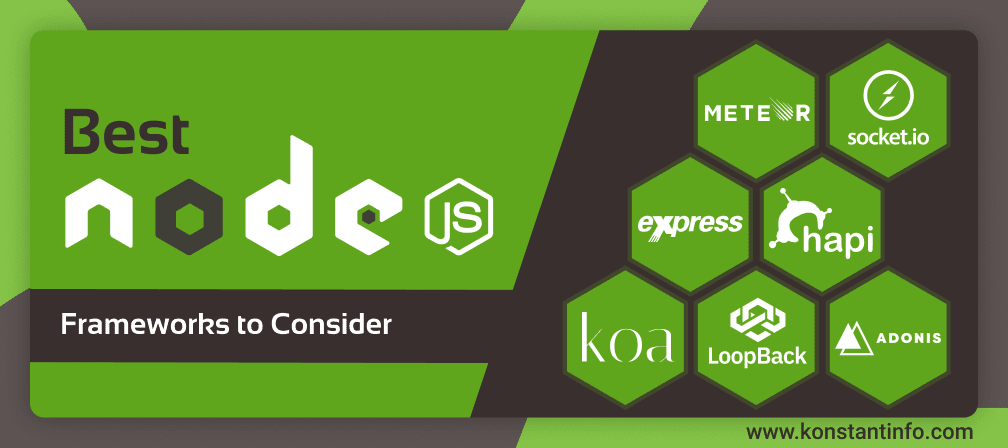
The competition in the market is growing at a rapid pace. All the product owners are seeking to develop a product that can draw the attention of people from every walk of life. To outpace this competition, you need to choose the right framework for your app.
If you want a product with excellence, then add Node.js development services to the preference list among other skills in JavaScript. It is a free, open-source JavaScript runtime environment that allows developers to have a reliable Node.js backend development process and data processing capabilities. Since its invention in 2009 by US software engineer Rayn Dahl, it has become a reliable solution for developing highly adjustable and interactive applications. It is easy to use and fast. Undeniably, the popularity of a Node.js development company has been on a roll among developers for its vast range of tools and single-threaded event loop model. Popular companies such as Netflix, Trello, LinkedIn, and PayPal use Node.js to allow better performance in their applications.
Node.js frameworks have various tools that allow developers to build apps quickly. These frameworks laid a foundation for developing an application, offering pre-built components like DBMS (data management system), templates, and best practices that help developers with faster web application development services. With the help of reusable code, developers can devote saved time to making the application logic efficient.
Many of us often encounter this question: Is Node.js itself a framework? It’s not. No, Node.js itself is not a framework. Let’s understand this:
Now, we know Node.js is an open-source JavaScript runtime environment that allows executing JavaScript code outside the web browser. This process opens the window of opportunities to create Server-side Applications, different tools, and many more using JavaScript.
On the other hand, A framework comes with a pre-defined structure on top of Node.js. It provides vast libraries and tools, and pre-written code that helps to ease the Node.js web development process. A framework like Express.js or Nest.js is quite helpful for offering additional features to help build applications efficiently.
Faster Development: If you want to develop an application faster with minimal effort and time, the Node.js framework is the best option due to its pre-built tools and applications.
Strengthen Security: There are many Node.js frameworks that provide strong security features to protect your application against basic application threats.
Vast community: Node.js framework enjoys the support of a vast community, from explanatory articles to tutorials that help you fix any issues during application development.
Real-time capabilities: Node.js is known for its management of real-time data, which makes it perfect for features like instant texting, live updating
There are several reasons why Node.js has gained tremendous popularity among developers to develop their dream app with cutting-edge features, a vast range of tools, and libraries. Given that the demand for Node.js continues to touch new heights, choosing the right framework becomes crucial. Node.js frameworks come with tools that make it easy to develop an application faster.
Let’s take an in-depth look at the best 10 Node.js frameworks for your app development:
Express.js is among the high-performing Node.js frameworks. It helps developers to build a server-side application and API at a quicker pace. Being lightweight and flexible, Express.js helps developers to create growable and manageable web application development services using JavaScript smoothly. Routing-Express helps users create a complex map URL without spending unnecessary time on writing boilerplate code.
Middleware: It acts as a building block for the app. Middleware makes it easy to add authentication and Error handling.
Pros:
Cons:
Koa.js is a well-known framework that is tiny but more expressive. Express.js developers created this lightweight framework, and for all the right reasons, it gained success over time because of its simplicity, adaptability, and extensibility. It is less complex than Express. This is why it is becoming the first choice among developers.
Pros:
Cons:
Meteor.js is a straightforward, open-source framework. It is frequently used to build real-time applications, such as instant updates and communication between clients and the server. It allows developers to apply the code again to create various applications.
Pros:
Cons:
It is an open-source framework built on top of Node.js. Sails.js follows the pattern of Model-View-Controller(MVC), similar to Ruby on Rails, offering easy maintenance of application code. It provides an effortless process of creating web applications and APIs. Sail.js also provides various pre-built features and plugins, such as authentication, session, and security, that speed up the process of building an application.
Pros:
Cons:
Adonis is like an advanced solution framework that follows the Model-View-Controller in Node.js. It provides all the necessary tools, such as routing, database management, validation, and authentication, to help Node.js for web development efficiently.
Pros:
Cons:
One of the most useful frameworks in Node.js is Loopback. Whether you want to create a straightforward API or an advanced microservices architecture, Loopback facilitates all the necessary tools to speed up web application development services and produce trustworthy, flexible solutions.
Pros:
Cons:
Totsl.js is a powerful, free, and open-source web application framework that uses Node.js to provide a mature solution for web developers to create different types of applications. Features such as automatic code generation, pre-built modules, and templates help to shorten the process of creating web apps, real-time applications, and many more. In terms of security concerns, Total.js is the most suitable as it has CSRF Protection.
Pros:
Restify.js framework is meant to create efficient, expandable, high-performance RESTful APIs. It is used for handling large volumes of data efficiently, making it a perfect choice for high-traffic applications. Major companies like Netflix and Pinterest use Restify.
Pros:
Cons:
Its stability and reliability make the Hampi.js framework the most popular among the Node.js platforms in 2025. It is made to ease the development of augmentable and powerful side-applications. It also helps with a set of features and plugins to make application testing and maintenance easy and simple. Hampi.js allows developers to add new functionality without writing new code over and over. It has a plugin system that helps developers create complex applications effortlessly.
Pros:
Cons:
Lacks community support.
NestJS is a flexible server-side framework for Node.js. It is made using TypeScript. It is ideal for building expendable test applications. The modular architecture of this platform allows developers to organise code into reusable modules, which helps to reduce time and effort for building new code for different projects. It is faster than most of the platforms. Nest.js also provides a range of pre-made templates and features like data management, authentication, and many more.
Pros:
Cons:
With the help of the Node.js development services, developers are able to easily build advanced applications. They create a base for building web applications, APIs, and server-side applications with minimal effort and time. It uses a faster process. Node.js framework’s pre-built tools and Structures help improve functionality and performance. This framework enjoys a large ecosystem of tools, which makes it easy to team up on projects and to find help.



Manish Jain is the co-founder and Managing Director at Konstant Infosolutions. He is responsible for the overall operations of the company and has played a major role in bringing Konstant up from its humble beginnings and, with his immense energy and drive, transforming it into a globally trusted name in IT solutions.
Or send us an email at: [email protected]